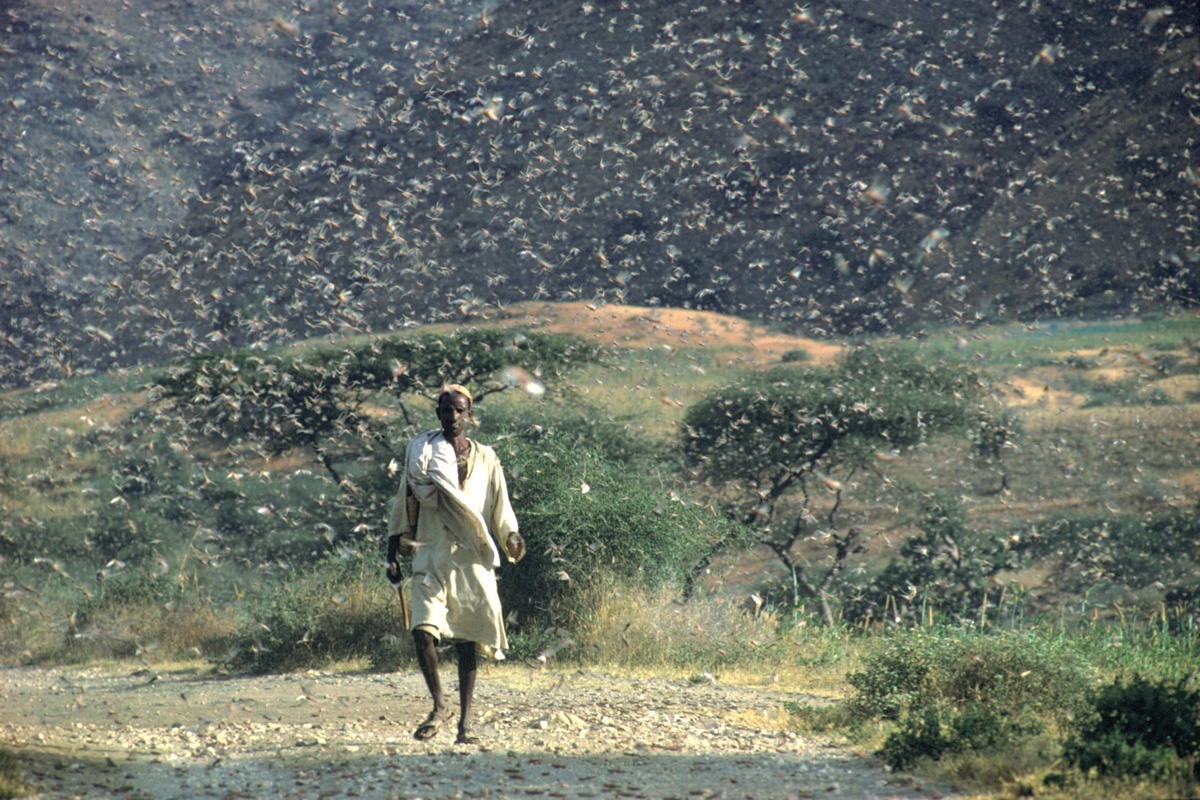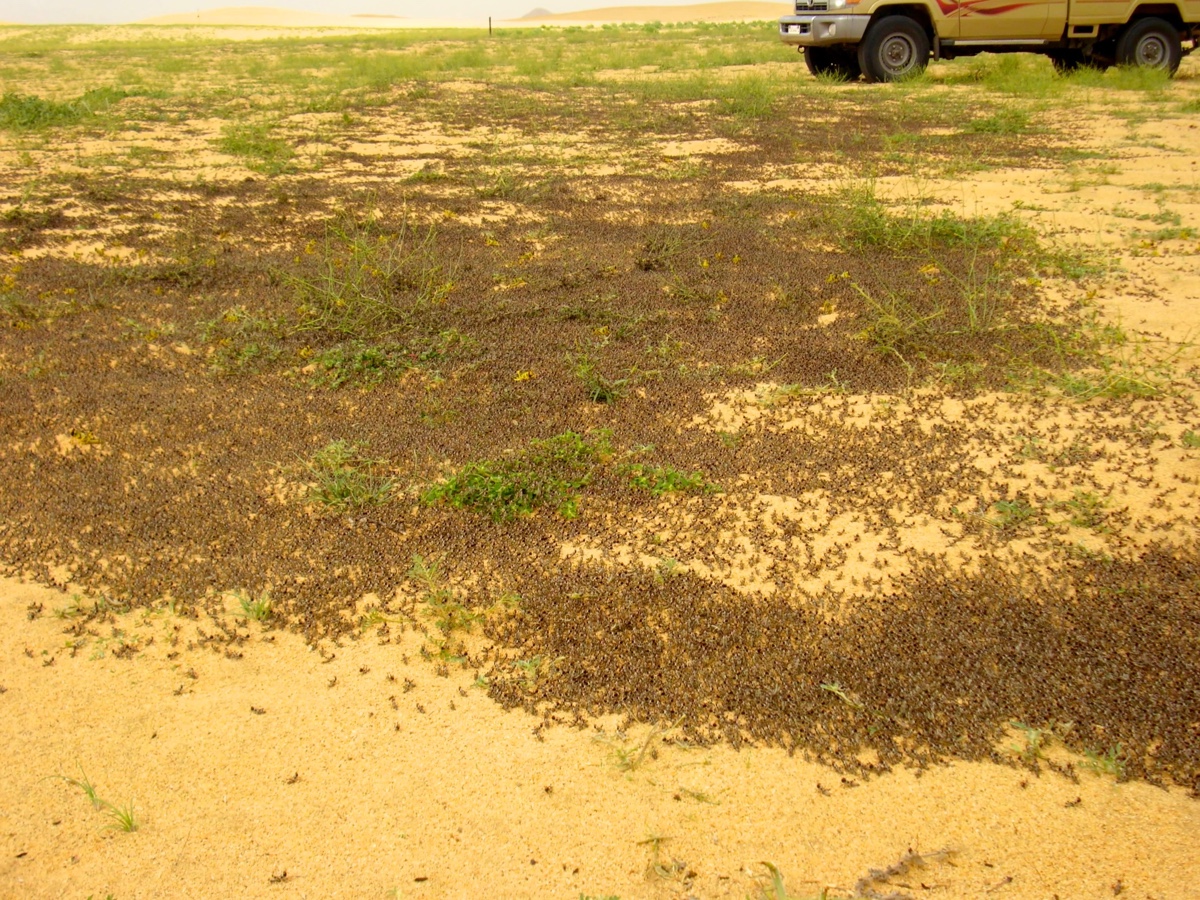New Weapon Against Desert Locust Plagues: Satellite Images

They can eat their weight in food daily. They can swarm in numbers reaching 40 million. And they can travel nearly 100 miles in a day. Desert locusts are not to be messed with.
But if scientists and officials have enough notice, they could put barriers in place to keep scattered locusts from forming swarms or even causing devastating plagues. A new satellite method may do just that.
Scientists have shown that using satellite images to calculate the amount of moisture in the soil could forecast a swarm of desert locusts 70 days before it forms. That's double the notice that officials had for a locust outbreak in the West African country of Mauritania in November 2016, said Keith Cressman, a senior locust forecasting officer at the Food and Agriculture Organization of the United Nations (FAO) in Rome. [Photos of Desert Locust Swarms]
Gregarious swarms
Desert locusts (Shistocerca gregaria) are a type of short-horned grasshopper. Unlike backyard grasshoppers, locusts can change their behavior from slow and solitary to gregarious, forming swarms of adults or bands of wingless nymphs called hoppers. The insects live in deserts across 50 countries, from West Africa to India.

And they are voracious. They can eat their weight in food each day, which is about 2 grams, according to the FAO. A swarm covering an area of 0.4 square miles (1 square kilometer) contains about 40 million locusts, which could devour, in one day, the same amount of food eaten by 35,000 people, according to the FAO.
Such swarms develop after hard rains following a drought cause moist soil and green vegetation, Cressman said. In a period of just six months, locusts that are normally scattered in low numbers throughout a desert can increase 500-fold, he said.
This surge in numbers is considered an outbreak.
Sign up for the Live Science daily newsletter now
Get the world’s most fascinating discoveries delivered straight to your inbox.
"During an outbreak, the locusts are starting to change from their normal solitary state to gregarious, forming small groups of hoppers and adults, a few hopper bands and perhaps a few small adult swarms," Cressman told Live Science. "If this outbreak is not detected or controlled in time and if good rains continue, the outbreak can develop into an upsurge that is much larger in scale and can affect several countries or an entire region." [Sting, Bite & Destroy: Nature's 10 Biggest Pests]
Similarly, if that upsurge isn't contained (and good conditions remain), Cressman explained, a plague can develop that can wreak havoc on an entire continent.
Predicting plagues
That's where soil moisture comes in. Cressman and his colleagues examined satellite images taken as part of the European Space Agency's (ESA) Soil Moisture and Ocean Salinity mission, which involves an orbiting radio telescope that picks up microwave emissions from Earth that can reveal soil moisture.
That data was combined with images captured by NASA's Earth-orbiting satellites called Aqua and Terra. The result? A map of soil moisture with a resolution of 0.6 miles (1 km) for every pixel, the researchers said.
Past forecasting methods relied on satellite images of green vegetation. Whereas those images alerted officials that optimal swarm conditions were present, it gave them only a month notice.
Soil moisture, however, can reveal that female locusts have a good place to lay their eggs, and that water is available for vegetation growth, the researchers said. In that way, this new method can give two to three months' notice in advance of an outbreak.
"Females are smart enough to know not to lay in dry soils. Therefore, knowing where the soil is sandy and moist can be a good indicator of where desert locust breeding will take place," Cressman said. "Locusts are also clever enough to lay [their eggs] in soil that is sufficiently moist not only to allow the eggs to hatch (after about two weeks) but also to allow enough annual vegetation to grow, which provides food and shelter for the wingless nymphs (hoppers) to develop and reach adulthood (after about 6 weeks)."
The advance notice can allow control teams to pre-position themselves in an outbreak area with pesticide sprayers, either mounted on vehicles or aircraft, or carried by individuals. Public awareness campaigns can also be launched so that people in affected areas know to contact officials with information about the locations of outbreaks.
"As the new product becomes operational and we gain valuable experience in its use, nuances and limitations, we will be able to incorporate the information it provides into forecasts and predictions concerning the scale, location and timing of breeding," Cressman wrote in an email to Live Science. "It is this breeding that causes locusts to increase rapidly, [become] gregarious and form nymphal (young wingless hoppers) bands and adult swarms."
Unlike the slow-moving solitary lifestyle, when locusts become gregarious, they are active, move fast and attract other locusts, according to research published in 2012 in the journal Nature Genetics.
Original article on Live Science.
Jeanna Bryner is managing editor of Scientific American. Previously she was editor in chief of Live Science and, prior to that, an editor at Scholastic's Science World magazine. Bryner has an English degree from Salisbury University, a master's degree in biogeochemistry and environmental sciences from the University of Maryland and a graduate science journalism degree from New York University. She has worked as a biologist in Florida, where she monitored wetlands and did field surveys for endangered species, including the gorgeous Florida Scrub Jay. She also received an ocean sciences journalism fellowship from the Woods Hole Oceanographic Institution. She is a firm believer that science is for everyone and that just about everything can be viewed through the lens of science.









